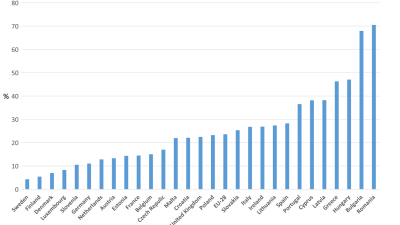During times of financial crisis Ferguson (1999, cited in Lee et al., 2004) suggests that individuals and households return to forgotten and (previously) redundant forms of economic and social behaviour in order to survive. The post-2008 economic climate could be said to offer such a situation. Leyshon and Thrift (1995) suggest that credit unions (community-based savings and loans institutions) are examples of 'alternative institutions of accumulation' to which Williams (1996) adds community currencies of which time banking is one variation. These currencies are community-based units of exchange with time banking associated to time (one hour of volunteering equals a one hour credit). So have credit unions and time banks expanded to offer a financial lifeline during the crisis?
Since 1997 credit unions have been increasingly visible in government strategies to tackle financial exclusion. Often cited as a means to provide loans to the most vulnerable and divert them from payday lenders and loan sharks, credit unions often provide small loans to people within a specific locality and 'common bond' (although some common bonds refer to places of work or political party membership). The size of loans made by credit unions rarely exceed £500 and are often associated with the cost of white-goods in the home and therefore would help those 14m identified by the PSE findings who have difficulty affording essential housing goods.
Government initiatives have in the same time period sought to promote the growth of the credit union movement. The Growth Fund, for example, was designed to help credit unions make instant loans to new members and avoid the usual 12 weeks savings pre-loan application, whilst other schemes sought to provide loans, financial advice and support a move out of debt. Consequently credit unions have been placed as a means to tackle financial insecurity. The early PSE findings show that over 30 million are financially insecure so there may still be a role for credit unions within government policy. Yet data for 2011 shows that, with just under 1 million members, the unions only provide a relatively minor 2.4% penetration into the UK population.
A similar argument holds with time banking. The coalition government have promoted the use of time banking in a number of documents (see Cabinet Office, 2011). Time banking allows community members to earn time credits through voluntary action. Each credit can often be used to access social activities (from tea and chat to art courses and French classes) offering potential to help those 12 million found in the PSE data to be too poor to engage in common social activity. Research into time banking since the late 1990s suggests that although it can be an effective tool for tackling social exclusion (Seyfang, 2003b, 2003a, 2004), it is less effective in terms of financial resources than other forms of community currency (North, 2005). However it has been suggested that time credits can act as an alternative resource which can be used instead of sterling thus providing additional resources for a household to help manage their consumption (Gregory, 2009). Unlike some forms of alternative currency, such as the well-publicised Bristol Pound and Brixton Pound, time banking does not require an exchange of sterling for the community currency. Rather it is earned and can act as an additional income. What still remains unclear is what impact time banking, or other community currencies, can have as part of an anti-poverty agenda. The evidence to date suggests potential impacts but has yet to explore these sufficiently.
The financial crisis has led to a renewed focus on potential alternative policy tools to facilitate survival at a time of low employment, stagnant wages and increased financial precariousness. Whilst credit unions have a much stronger evidence base regarding their effectiveness their role in government strategies remains hotly contented. Time banking however is only now starting to find a place in government strategies. Consequently there is a need for greater attention on the potential anti-poverty contribution that these institutions can offer.
References
Cabinet Office 2011, 'Giving White Paper' London: The Stationery Office Limited.
Gregory, L. 2009, 'Spending Time Locally: The Benefits of Time Banks for Local Economies' Local Economy, 24, 23-333.
Leyshon, A. & Thrift, N. 1995. 'Geographies of Financial Exclusion: Financial Abandonment in Britain and the United States'. Transactions of the Institute of British Geographers, 20, 312-341.
North, P. 2005. 'Scaling alternative economic practices? Some lessons from alternative currencies'. Transactions of the Institute of British Geographers, 30, pp. 221-233.
Seyfang, G. 2003a. 'Growing Cohesive Communities One Favour at a Time: Social Exclusion, Active Citizenship and Time Banks'. International Journal of Urban and Regional Research, 27, 699 -706.
Seyfang, G. 2003b. 'With a little help from my friends. Evaluating time bank as a tool for community self-help'. Local Economy, 18, 257-264.
Seyfang, G. 2004. 'Working outside the box: Community currencies, time banks and social inclusion'. Journal of Social Policy, 33, 49-71.
William, C. C. 1996. 'The new barter economy: An appraisal of local exchange and trading systems (LETS)'. Journal of Public Policy, 16, 85-101.
Lee Gregory is a Lecturer in Social Policy at the University of Bristol, School for Policy Studies. From September 2013 he will be Lecturer in Social Policy at the University of Birmingham, School of Social Policy.



 PSE:UK is a major collaboration between the University of Bristol, Heriot-Watt University, The Open University, Queen's University Belfast, University of Glasgow and the University of York working with the National Centre for Social Research and the Northern Ireland Statistics and Research Agency. ESRC Grant RES-060-25-0052.
PSE:UK is a major collaboration between the University of Bristol, Heriot-Watt University, The Open University, Queen's University Belfast, University of Glasgow and the University of York working with the National Centre for Social Research and the Northern Ireland Statistics and Research Agency. ESRC Grant RES-060-25-0052.






